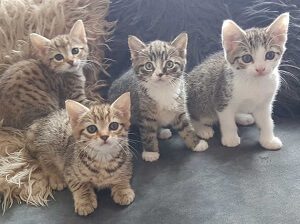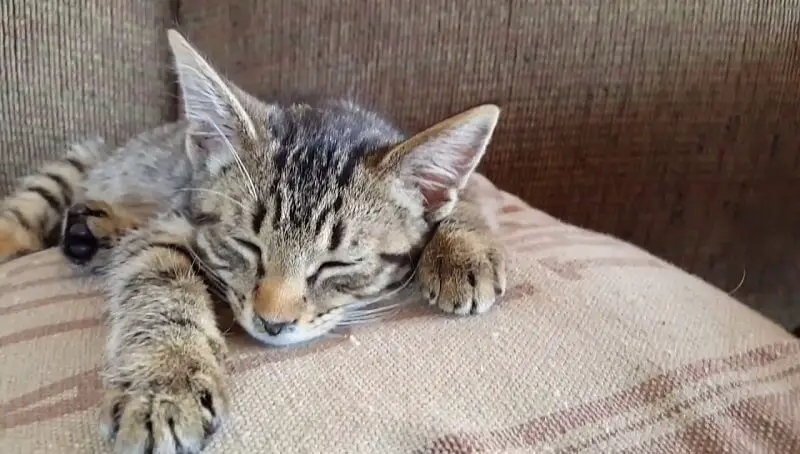Although not among the most popular breeds of cats in the world, the Bengal cat is still recognized as one of the most athletic and active. With their muscled and lithe build, they will be able to jump very high in the air. Their complex physical appearance and their luxurious-looking coat are what make more and more pet owners in love with their looks. But before you buy it, is there any way of finding out of you’re getting a purebred or a Bengal tabby mix?
Bengal Tabby Mix: How to spot it
Tabby is not a specific breed but a coat pattern, which makes spotting a Bengal tabby mixed cat a pretty easy job. A tabby cat regardless of its breed will have stripes around the legs and tail, along its back, and also around the cheeks and eyes, and a very noticeable M-shaped marking on its forehead. Tabby cats, although different across breeds, will almost always be very smart, affectionate, and friendly with close people.
You might also like my articles on why would a cat have black boogers, why you shouldn’t cut a cat’s whiskers, and why won’t a cat eat prescription food.
Currently, there are five tabby patterns that are more popular, and these are:
- The Spotted tabby – This cat will have either small or large spots all over the sides of its body, sometimes being very similar to mackerel stripes.
- The Patched tabby – A cat that is usually known as either a tortie tabby or a tortoiseshell, with individual patches of red and brown tabby patterns. A tortie cat that also comes with tabby genes will be called a torbie.
- The Ticked tabby – This type of cat won’t have too well-known traditional spots or stripes, except for some tabby markings on its face and some hairs that are striped with alternating dark and light bands.
- The Mackerel tabby – This is what most people will call a tiger cat, with narrow stripes coming down in parallel on the sides in a vertical pattern. These stripes will usually look just like a fish skeleton.
- The Classic tabby – This is the most common tabby and will have swirling patterns on the sides, similar to a marble cake. This cat is also known as a blotched tabby.
But what about the Bengal cat breed? What are its main physical traits and behavior particularities?
Bengal cats were made by crossbreeding the Asian leopard cat with a domestic cat to create a more obedient specimen but with an exotic appearance and a unique coat pattern and color. These cats are usually medium to large in size. The first time this cross between breeds was attempted was in the United States of America, around 1960. Except for the whisker pad, the chin, and the belly area, a Bengal will usually have no other white spots on its body. Instead, it will have a really nice-colored pattern. The tip of its hair strands will usually contain less pigment, which means that when light hits it, it will sparkle. The fur is pelted or soft and strands are individually ticked.
Common physical traits
- Body length: 14 to 19 inches
- Height: 8 to 10 inches
- Weight: 12 to 16 pounds
- Lifespan: 9 to 16 years
- Coat length: short
- Patterns: spots, ticking, tabby, rosettes (clouded, cluster, arrowhead, donut, paw print, spotted)
- Colors: red, torbie, blue, cinnamon, black, seal, brown, silver, snow, or smoke
- Eye color: orange, yellow, brown, or blue
You will notice that Bengals have a thick tail, large feet, and a thick neck, but also a triangular-shaped head. With a medium-length leg, they have really strong muscles they count on.
Personality traits and behavior
 Although most people consider that Bengal cats are closer to wild animals than other breeds of cats, if you were to buy a domesticated specimen or one that has been separated from the wild for a few generations, you will notice it is more affectionate, loving and sweet. They will get very close to their owners and will be loyal for all their lives. You will have to match their energy because they really like to run, romp and jump around. This breed is also very alert and curious. This means that you will have to be prepared for an agile, playful, and energetic pet.
Although most people consider that Bengal cats are closer to wild animals than other breeds of cats, if you were to buy a domesticated specimen or one that has been separated from the wild for a few generations, you will notice it is more affectionate, loving and sweet. They will get very close to their owners and will be loyal for all their lives. You will have to match their energy because they really like to run, romp and jump around. This breed is also very alert and curious. This means that you will have to be prepared for an agile, playful, and energetic pet.
Although these cats like to climb in high areas and jump all-around your home during the day, they are loving and will demand your companionship throughout the night. Their strong memory enables them to learn tricks pretty easily and they can be taught to do anything from opening doors, to high fiving, sitting, and lying down. They will also learn most human expressions and gestures easily. They love to play around water and are in no way aggressive unless trained like that. Their constant need for stimulation can be kept under control with the use of interactive cat toys that can offer the needed exercise to your animals.
So, how does one ascertain if their cat is a Bengal tabby mix?
Considering the factors discussed above, it is safe to presume that your cat is a Bengal tabby mix if it possesses the characteristics of a Bengal cat but also has a distinctive tabby pattern. You may check your cat’s color markings and patterns and compare them with the common tabby patterns mentioned above to have an accurate match. You may also consult a local breeder or your veterinarian to help you in determining if your cat is a Bengal tabby mix if you have doubts.
Is it safe to own a Bengal tabby mix cat in a home?
Are there any legal issues?
To answer both questions at once, it is not only legal, but also safe to own a Bengal tabby mix cat in the USA, but also in Australia and Europe, as long as your cat will be separated from its wild ancestor, the Asian leopard cat, for more than five generations. Even though the vast majority of US cities will have no issues with you owning this kind of cat, there are others, and I must say, they aren’t small cities, like Seattle, Hawaii, Connecticut, and New York City, that won’t allow you to get this type of cat, regardless of their filial stage.
Conclusion
You will usually recognize a Bengal cat due to its athletic build, luxurious coat, and very affectionate nature. These cats are very smart, agile, and amazing jumpers. You should look in your cat for physical qualities, behavior, and temperament traits to see if it is a Bengal tabby mix. It should also have the unique tabby patterns in her coat.




